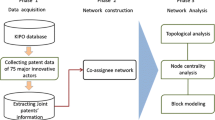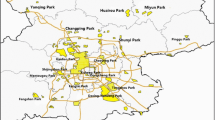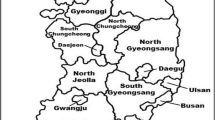Abstract
It is important to optimize the cooperative innovation network for the improvement of economic competence and innovative power. Based on the patent information services platform, we obtain invention patent data for the electronic information industry in Liaoning from 1985 to 2015. This paper analyzes the cooperative innovation network structure, its spatiotemporal evolution and the triple helix relationship of government-industry-university (GIU) by using the social network analysis method and the triple helix theory as well as UCINet, ArcGIS and NetDraw. The empirical results show that: 1) the number of the subjects of the electronic information industry GIU cooperative innovation network in Liaoning demonstrates a gradual increase from 1985 to 2015, with the same trend in concentration. In terms of its subject and its centrality, the universities have a higher position, and the industries have a lower position, while the status of the government is still unclear. 2) The cooperative innovation network presents a core-periphery structure, and the polarization effect of innovation subjects tends to be obvious. There is certain distance-decay regularity in the cooperative innovation network, and a strong geographical proximity to cooperative innovation. 3) The compactness shows a downward trend as a whole. In terms of the extent of participation, the industries are better than the government but worse than the universities. This means that the cooperative innovation network of GIU in the electronic information industry in Liaoning is in the initial stage of formation.
Similar content being viewed by others
References
Balland P A, 2012. Proximity and the evolution of collaboration networks: evidence from research and development projects within the global navigation satellite system (GNSS) industry. Regional Studies, 46(6): 741–756. doi: https://doi.org/10.1080/00343404.2010.529121
Balland P A, Boschma R, Frenken K, 2015. Proximity and innovation: from statics to dynamics. Regional Studies, 49(6): 907–920. doi: https://doi.org/10.1080/00343404.2014.883598
Boschma R, 2005. Proximity and innovation: a critical assessment. Regional Studies, 39(1): 61–74. doi: https://doi.org/10.1080/0034340052000320887
Boschma R, Frenken K, 2009. The spatial evolution of innovation networks: a proximity perspective. Papers in Evolutionary Economic Geography, (0905):1–17.
Choi J, Sang-Hyun A, Cha M S, 2013. The effects of network characteristics on performance of innovation clusters. Expert Systems with Applications, 40(11): 4511–4518. doi: https://doi.org/10.1016/j.eswa.2013.01.052
Etzkowitz H, Leydesdorff L, 1995. The triple helix-university-industry-government relations: a laboratory for knowledge based economic development. EASST Review, 14(1): 14–19.
Etzkowitz H, Leydesdorff L, 2000. The dynamics of innovation: from National Systems and “Mode 2” to a Triple Helix of university-industry-government relations. Research Policy, 29(2): 109–123. doi: https://doi.org/10.1016/S0048-7333(99)00055-4
Etzkowitz H, 2002. Incubation of incubators: innovation as a triple helix of university-industry-government networks. Science & Public Policy, 29(2): 115–128. doi: https://doi.org/10.3152/147154302781781056
Etzkowitz H, 2003. Innovation in innovation: the triple helix of university-industry-government relations. Social Science Information, 42(3): 293–337. doi: https://doi.org/10.1177/05390184030423002
Fiaz M, Rizran B, 2011. University-industry ecosystem: factors for collaborative environment. In: Software Engineering, Business Continuity, and Education. Berlin Heidelberg: Springer, 651–661. doi: https://doi.org/10.1007/978-3-642-27207-3_71
Freeman L C, 1978. Centrality in social networks conceptual clarification. Social Networks, 1(3): 215–239. doi: https://doi.org/10.1016/0378-8733(78)90021-7
Hagedoorn J, Cloodt M, 2003. Measuring innovative performance: is there an advantage in using multiple indicators?. Research Policy, 32(8): 1365–1379. doi: https://doi.org/10.1016/S0048-7333(02)00137-3
Hu Yang, Li Xun, 2016. Effect of geographical proximity on university-industry cooperative innovation and the Mechanism. Economic Geography, 36(6): 109–115. (in Chinese)
Huallacháin B Ó, Lee D S, 2014. Urban centers and networks of co-invention in American biotechnology. The Annals of Regional Science, 52(3): 799–823. doi: https://doi.org/10.1007/s00168-014-0610-8
Huang Haiying, 2011. Development status and upgrade path of Liaoning Electronic Information Industry Cluster. China Urban Economy, (26): 38–39+41. (in Chinese)
Kaygalak I, Reid N, 2016. Innovation and knowledge spillovers in Turkey: the role of geographic and organizational proximity. Regional Science Policy & Practice, 8(1–2): 45–60. doi: https://doi.org/10.1111/rsp3.12072
Lazzeretti L, Capone F, 2016. How proximity matters in innovation networks dynamics along the cluster evolution. A study of the high technology applied to cultural goods. Journal of Business Research, 69(12): 5855–5865. doi: https://doi.org/10.1016/j.jbusres.2016.04.068
Leydesdorff L, 2003. The mutual information of university-industry-government relations: an indicator of the Triple Helix dynamics. Scientometrics, 58(2): 445–467. doi: https://doi.org/10.1023/A:1026253130577
Li Erling, Yao Fei, Xi Jiaxin et al., 2018. Evolution characteristics of government-industry-university-research cooperative innovation network for China’s agriculture and influencing factors: illustrated according to agricultural patent case. Chinese Geographical Science, 28(1): 137–152. doi: https://doi.org/10.1007/s11769-017-0924-4
Liefner I, Hennemann S, 2011. Structural holes and new dimensions of distance: the spatial configuration of the scientific knowledge network of China’s optical technology sector. Environment & Planning A, 43(4): 810–829. doi: https://doi.org/10.1068/a43100
Liu J, 2014. How do geographical and organisational proximity influence the relational pattern of MNCs’ global innovation networks: an in-depth case study. Papers in Innovation Studies.
Liu X F, Wang J B, Ji D K, 2011. Network characteristics, absorptive capacity and technological innovation performance. International Journal of Technology Policy & Management, 11(2): 97–116. doi: https://doi.org/10.1504/IJTPM.2011.040398
Liu Xueyuan, Ding Wenjing, Zhao Xiande, 2016. Firm’s strength of ties within innovation network, absorptive capacity and innovation performance in the Chinese manufacturing industries. Nankai Business Review, 19(1): 30–42. (in Chinese)
Lyu Guoqing, Zeng Gang, Gu Nana, 2014. Dynamic evolution of innovation network in China's equipment manufacturing industry: geographic proximity versus social proximity. China Soft Science, (5): 97–106. (in Chinese)
Mêgnigbêto E, 2014. Efficiency, unused capacity and transmission power as indicators of the Triple Helix of university-industry-government relationships. Journal of Informetrics, 8(1): 284–294. doi: https://doi.org/10.1016/j.joi.2013.12.009
Mayhew B H, Levinger R L, 1976. Size and the density of interaction in human aggregates. American Journal of Sociology, 82(1): 86–110. doi: https://doi.org/10.1086/226271
Morescalchi A, Pammolli F, Penner O et al., 2015. The evolution of networks of innovators within and across borders: evidence from patent data. Research Policy, 44(3): 651–668. doi: https://doi.org/10.1016/j.respol.2014.10.015
Ter Wal A L J, 2014. The dynamics of the inventor network in German biotechnology: geographic proximity versus triadic closure. Journal of Economic Geography, 14(3): 589–620. doi: https://doi.org/10.1093/jeg/lbs063
van Geenhuizen M, Ye Q, Taheri M, 2016. Hidden mediator roles of university spin-offs in Triple Helix networks. Triple Helix, 3(1): 5. doi: https://doi.org/10.1186/s40604-016-0034-9
Wang Qiuyu, Zeng Gang, Lyu Guoqing, 2016. Structural evolution of innovation networks of China’s equipment manufacturing industry. Acta Geographica Sinica, 71(2): 251–264. (in Chinese)
Xie X M, Zuo L L, Zeng S X et al., 2014. The impacts of network structures and network form on corporate innovative performance: evidence from high-tech sectors. Asian Journal of Technology Innovation, 22(2): 185–203. doi: https://doi.org/10.1080/19761597.2014.983678
Ye F Y, Yu S S, Leydesdorff L, 2013. The Triple Helix of university-industry-government relations at the country level and its dynamic evolution under the pressures of globalization. Journal of the American Society for Information Science & Technology, 64(11): 2317–2325. doi: https://doi.org/10.1002/asi.22931
Zhang Ying, 2015. Convergence Degree Evaluation of the Information Idustry and the Econometric Analysis of Effect on Economic Growth: A Case of Liaoning Province. Shenyang: Dongbei University of Finance and Economics, Shenyang. (in Chinese)
Author information
Authors and Affiliations
Corresponding author
Additional information
Foundation item: Under the auspices of National Natural Science Foundation of China (No. 41601114), Humanities and Social Science Foundation of Ministry of Education (No. 16YJC790080), Social Science Fund of Liaoning Province (No. L17CJL001), Education Project of Liaoning Provincial Department (No. JZ201783606)
Rights and permissions
About this article
Cite this article
Peng, F., Zhang, Q., Han, Z. et al. Evolution Characteristics of Government-Industry-University Cooperative Innovation Network of Electronic Information Industry in Liaoning Province, China. Chin. Geogr. Sci. 29, 528–540 (2019). https://doi.org/10.1007/s11769-019-1047-x
Received:
Accepted:
Published:
Issue Date:
DOI: https://doi.org/10.1007/s11769-019-1047-x




